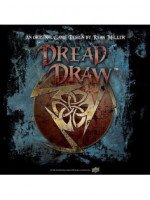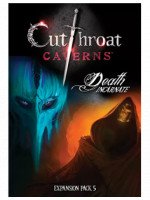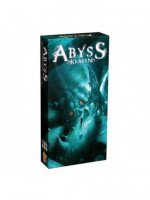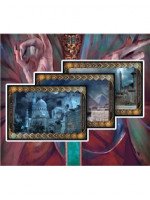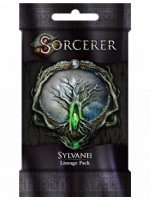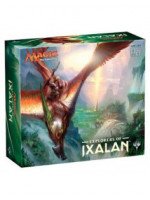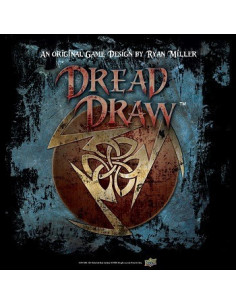
Dread Draw
Dread Draw is a strategy card game of press your luck competitive fortune telling.
Setting Up a Game:
At the beginning of the game each player is dealt 10 cards face down. These cards form each player’s Life Deck. Players can never look at the cards in their Life Deck unless the game or a card effect allows them to.
Playing the Game:
The game is played in a series of rounds. During each round players take turns in trying to summon cards. A round ends when only one player remains making that player the winner of that round. A new round then begins.
At the end of the round each eliminated player will take damage which is represented by discarding cards from their Life Deck. If you are eliminated and have no cards in your Life Deck then you are defeated and are out of the game. The last player remaining in the game wins!
The Turn:
The player who was randomly chosen to go first takes the first turn of the opening round. On your turn you must try to summon a card. Initially you’ll try to summon a card from the Draw Deck but as the game progresses you might be able to summon cards from your reserves as you accumulate them. To summon a card from the top of the Draw Deck reveal that card. If its strength is greater than the strength of the last card you summoned then you’ve successfully summoned that card. Place it to the right of the last card you summoned. This is known as Escalating.
If you summoned the card successfully you may use any Summon ability that it may have; though using it is entirely optional. If the card’s strength is not greater than the last card you summoned then discard the card you drew from the Draw Deck and you are eliminated from the round. Discard any other cards you summoned this round.
After a player summons a card or fails to summon a card play passes to the player with the lowest total strength among their summoned cards. If there is a tie and the current player is one of the tied players then the current player takes the next turn. Otherwise play passes to the next player to their left that is tied for lowest. If the Draw Deck runs out of cards shuffle the cards in the discard pile to make a new Draw Deck.
Ending the Round:
A round ends when only one player remains in the round. The winning player adds up the damage values of their summoned cards. Each ‘Red dot’ on a summoned card represents a single damage point. Each opponent takes that much damage starting with the player to the winner’s left and going around the table. Once each player has taken their damage from their Life Deck the winner discards their summoned cards and becomes the starting player for the next round.
The Life Deck:
Whenever you take damage draw that many cards from your Life Deck and choose one of them to go to your reserves. Discard the other cards.
If you’re out of cards while drawing you are still in the game — you don’t get defeated until you take damage while having no cards in your Life Deck.
If an ability allows you to gain life put that many cards from the Draw Deck on top of your Life Deck without looking at them.
The Reserves:
Whenever you place a card in your reserves put it next to your Life Deck so you don’t confuse it with the cards you summon during the round. If the card has a Reserve ability you may play it now. Whenever you must summon a card you may choose to summon one from your reserves instead of revealing a card from the Draw Deck. You can choose any card with strength greater than the last card you summoned this round and put it to the right of that card. If it has a Summon ability you may play it — play then passes per the normal rules.
Abilities:
Most abilities on cards have a keyword that tells you when to play that ability. Playing summon reserve and aftermath abilities are always optional.
Summon: Play this when you successfully summon the card.
Reserve: Play this when the card is placed into your reserves regardless of where it came from.
Aftermath: Play this when you are eliminated from a round or at the end of the round that you won.
Cards have special abilities that do not fall under any other ability category are considered to be “always on” even while they are in your reserves. These abilities are not optional.
Telling the Fortune:
Once the game is over if the winner had any cards left in their Life Deck they use those cards to divine the future. That player shuffles those cards and lays them out face-up one at a time. The first card represents the present the second represents the immediate future and the rest divine the far future. It’s up to the players to interpret what those cards mean.
AlgemeenAantal spelers: 2-5
Speelduur: 15 min.
Leeftijd: 14+
Taal: Engels
Soort spelType/Thema: Card Game Fantasy
Mechanisme: Player Elimination Push Your LuckMakersOntwerper: Ryan Miller
- Deze editie is in het Engels.
- Geschikt voor 2 - 5 spelers.
- Je bent ongeveer 30 min. aan het spelen.
- Vanaf 14 jaar is dit spel te spelen.
Dread Draw aanbiedingen:
-
- Bezorgkosten: € 6,00
- Levertijd: Voor 16:00 besteld, volgende werkdag in huis.
Op basis van 54 ervaringen op het toonaangevende Boardgamegeek.com
Dread Draw is a strategy card game of press your luck competitive fortune telling.
Setting Up a Game:
At the beginning of the game each player is dealt 10 cards face down. These cards form each player’s Life Deck. Players can never look at the cards in their Life Deck unless the game or a card effect allows them to.
Playing the Game:
The game is played in a series of rounds. During each round players take turns in trying to summon cards. A round ends when only one player remains making that player the winner of that round. A new round then begins.
At the end of the round each eliminated player will take damage which is represented by discarding cards from their Life Deck. If you are eliminated and have no cards in your Life Deck then you are defeated and are out of the game. The last player remaining in the game wins!
The Turn:
The player who was randomly chosen to go first takes the first turn of the opening round. On your turn you must try to summon a card. Initially you’ll try to summon a card from the Draw Deck but as the game progresses you might be able to summon cards from your reserves as you accumulate them. To summon a card from the top of the Draw Deck reveal that card. If its strength is greater than the strength of the last card you summoned then you’ve successfully summoned that card. Place it to the right of the last card you summoned. This is known as Escalating.
If you summoned the card successfully you may use any Summon ability that it may have; though using it is entirely optional. If the card’s strength is not greater than the last card you summoned then discard the card you drew from the Draw Deck and you are eliminated from the round. Discard any other cards you summoned this round.
After a player summons a card or fails to summon a card play passes to the player with the lowest total strength among their summoned cards. If there is a tie and the current player is one of the tied players then the current player takes the next turn. Otherwise play passes to the next player to their left that is tied for lowest. If the Draw Deck runs out of cards shuffle the cards in the discard pile to make a new Draw Deck.
Ending the Round:
A round ends when only one player remains in the round. The winning player adds up the damage values of their summoned cards. Each ‘Red dot’ on a summoned card represents a single damage point. Each opponent takes that much damage starting with the player to the winner’s left and going around the table. Once each player has taken their damage from their Life Deck the winner discards their summoned cards and becomes the starting player for the next round.
The Life Deck:
Whenever you take damage draw that many cards from your Life Deck and choose one of them to go to your reserves. Discard the other cards.
If you’re out of cards while drawing you are still in the game — you don’t get defeated until you take damage while having no cards in your Life Deck.
If an ability allows you to gain life put that many cards from the Draw Deck on top of your Life Deck without looking at them.
The Reserves:
Whenever you place a card in your reserves put it next to your Life Deck so you don’t confuse it with the cards you summon during the round. If the card has a Reserve ability you may play it now. Whenever you must summon a card you may choose to summon one from your reserves instead of revealing a card from the Draw Deck. You can choose any card with strength greater than the last card you summoned this round and put it to the right of that card. If it has a Summon ability you may play it — play then passes per the normal rules.
Abilities:
Most abilities on cards have a keyword that tells you when to play that ability. Playing summon reserve and aftermath abilities are always optional.
Summon: Play this when you successfully summon the card.
Reserve: Play this when the card is placed into your reserves regardless of where it came from.
Aftermath: Play this when you are eliminated from a round or at the end of the round that you won.
Cards have special abilities that do not fall under any other ability category are considered to be “always on” even while they are in your reserves. These abilities are not optional.
Telling the Fortune:
Once the game is over if the winner had any cards left in their Life Deck they use those cards to divine the future. That player shuffles those cards and lays them out face-up one at a time. The first card represents the present the second represents the immediate future and the rest divine the far future. It’s up to the players to interpret what those cards mean.
AlgemeenAantal spelers: 2-5
Speelduur: 15 min.
Leeftijd: 14+
Taal: Engels
Soort spelType/Thema: Card Game Fantasy
Mechanisme: Player Elimination Push Your LuckMakersOntwerper: Ryan Miller
| Naam | Dread Draw |
|---|---|
| EAN | 53334865678 |
| Taal | Engels |
| Aantal spelers | 2 - 5 |
| Speeltijd | 30 min. |
| Minimale leeftijd | 14 jaar |
| Uitgever | Upper Deck Entertainment |

